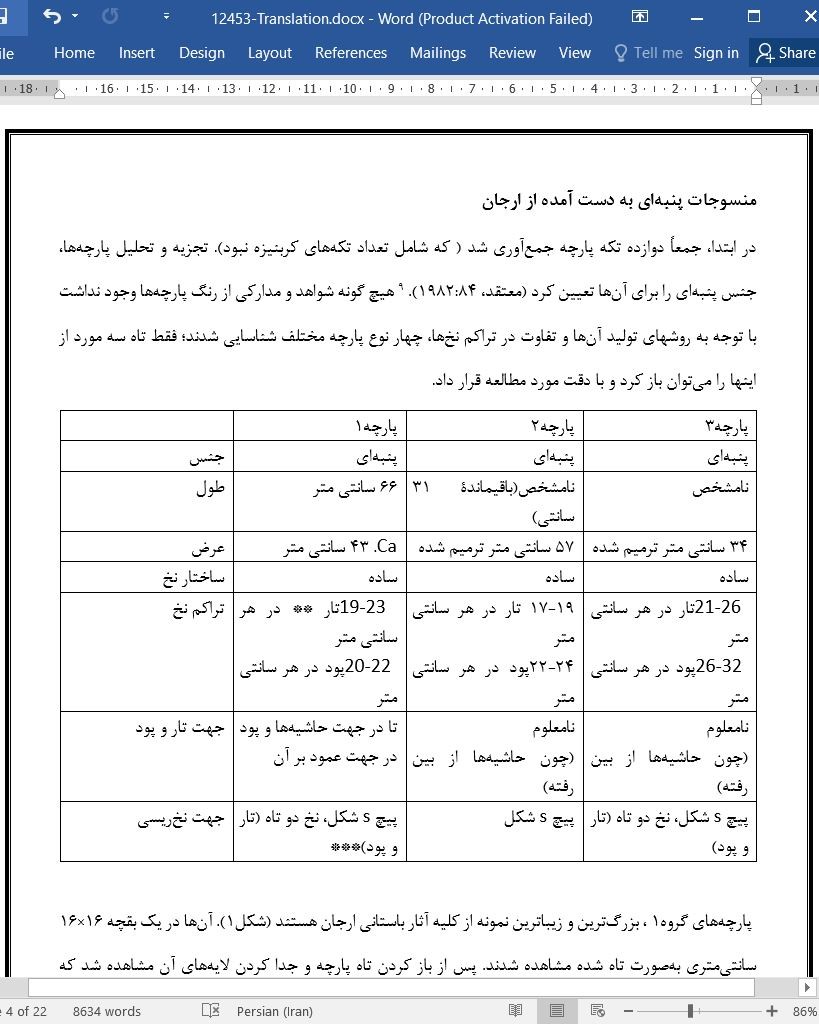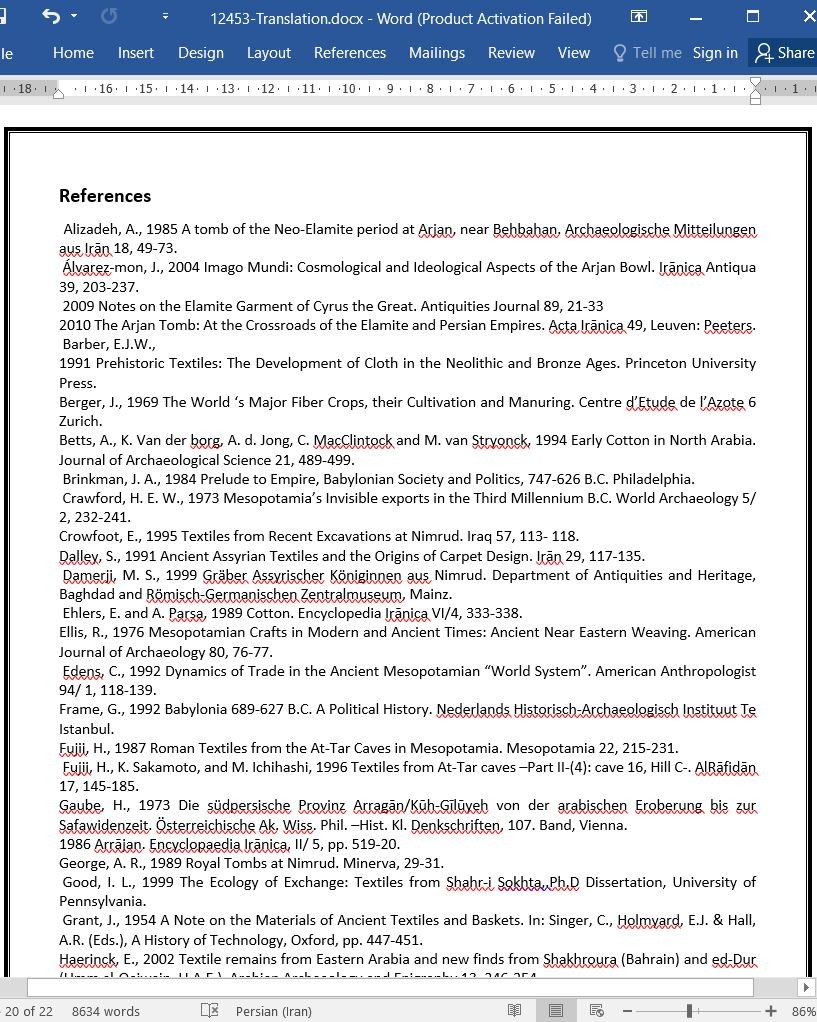
دانلود مقاله معرفی پنبه در خاور نزدیک: چشم اندازی از ایلام
چکیده
در سال 1982 مقبرهای ارزشمند در ارجان، نزدیک به بهبهان امروزی کشف شد. آن در یک تابوت برنزی از منسوجات پنبهای و پلاکهای طلایی قرار داشت که نشان میداد استفاده از این لباسها به سالهای فروپاشی امپراتوری ایلامی برمیگردد. هدف اصلی از این مطالعه بررسی پیامدهای این اکتشاف در تاریخ پوشاک و بهویژه ارائه یک درک تاریخی جدید در مورد منشاء پنبه و ورود آن به خاور نزدیک است.
اگر به نقشه آسیا نگاهی بیندازید و رودخانه فرات را از خلیج فارس با فاصله کمی از رودخانه دنبال کنید، به محل شهر باستانی بابل خواهید رسید. در دوران نبوکدنصر ، حدود 575 B.C این شهر مشهورترین شهر جهان بود. تمام داد و ستدهای نامعلوم هند و چین با غرب از طریق خیابانهای این شهر انجام میشد. کالاهای ابریشمی و پنبهای که دارای ظریفترین بافت بودند توسط تجار به آن وارد شدند. اما این کالاهای زیبا و گرانقیمت از کجا آمدهاند؟(E.C.Brooks. ماجرای پنبه، 1911:20(
مقدمه
این مقاله به عنوان ادامه مطالعه ارزشمند انجام شده توسط معتقد (منسوجات کشفشده در تابوت برنزی Kitin Hutran در ارجان ، بهبهان" (1982) ارائه میشود. ازآنجاییکه مطالعه معتقد در اصل به زبان فارسی نوشته شده بود، در ابتدا خلاصه و تفسیری از این یافتهها ارائه میشود. بخش دوم این مقاله به طور مستقیم با اهمیت این کشف مرتبط است. بقای استثنایی منسوجات نخی (پنبهای) از جنوب ایران، محافظت و بررسی آنها فرصتی را برای ارزیابی مجدد دیدگاههای گذشته و ارائه دیدگاههای جدید در مورد منشاء پنبه و معرفی آن به خاور نزدیک میطلبد.
نتیجهگیری
اگر تلاش کنیم شواهد ارائه شده را گرد هم آوریم، میتوانیم به برخی از واقعیتها و فرضیات بسیار خوب دیگر دست پیدا کنیم. باقی ماندن لباسهای پنبهای در مقبره ارجان به خودی خود از اهمیت ویژهای برخوردار است. ما برای اولین بار با شواهدی مسلم از پوشاک تهیه شده از پنبه در شرق نزدیک باستان مواجه میشویم. این شواهد به تأیید بیشتر در مورد وجود پارچه تهیه شده از پنبه در مقبره سلطنتی آشور که احتمالاً متعلق به ملکه Ataliâ ، همسر سارگون دوم است کمک میکند. این واقعیت که هر دو نمونه آشوری و لباسهای پنبهای ارجان در بهترین حالت تدفین یافته شدند، به پایان قرن هشتم و هفتم B.C.E.مربوط میشود که به ترتیب نشان میدهد که آشوریان و ایلامیها به گونهای به پنبه دسترسی داشتند که ظاهراً در منابع متنی موجود انعکاس نیافته است.
در عوض منابع این موضوع را مطرح میکنند که پنبه در دوره حکومت هخامنشی در هند، جزیره دیلمون و مصر کشت میشد. متأسفانه کمبود شواهد ایلامی نو، جای زیادی برای بحث و گفتگو در مورد وجود و اهمیت داد و ستد سازمان یافتۀ این الیاف لوکس و منحصربهفرد باقی نمیگذارد. با این حال، کشت پنبه در دیلمون نشان میدهد که پنبه ایلامی به دست آمده از ارجان و احتمالاً پنبه آشوری به دست آمده از نمرود، از این جزیره منشاء گرفته است. خواه ناخواه، تجارت دریایی بین بنادر ایلامی و دیلمون در واقع باید با کاوشهای آینده و در حالت ایده آل زمانیکه ایران بار دیگر به صحنه پویای کارهای میدانی متمرکز همانند قبل برگردد، مشخص شود.
Abstract
In 1982 an elite burial was discovered in Arjan, near modern Behbahan. The presence inside the bronze coffin of cotton textiles and gold bracteates suggesting the use of garments dated to the waning years of the Elamite Empire. The main purpose of this study is to examine the implications of this discovery for the history of garments and, most particularly, to offer a new historical understanding regarding the origins of cotton and its introduction into the Near East.
If you will take your map of Asia and trace the Euphrates River from the Persian Gulf a short distance up the river, you will come to the site of the ancient city of Babylon. In the days of Nebuchadnezzar, about 575 B.C., it was the most celebrated city in the world. All the trade of unknown India and China going westward flowed through its streets. Silk and cotton goods of finest texture were brought in by traders. But where did these beautiful and costly goods come from? (E.C. Brooks, The Story of Cotton, 1911: 20)
Introduction
This article is presented as a continuation to the valuable study by Susan Mo’taghed, “Textiles Discovered in the Bronze Coffin of Kitin Hutran in Arjan, Behbahan” (1982).1 Because Mo’taghed’s study was originally written in the Persian language, a summary and commentary on the findings will first be presented.2 The second part of this article is directly related to the significance of this discovery. The exceptional survival of cotton textiles from southern Irān, their conservation, and study invites the opportunity to reassess past views and offer new ones regarding the origins of cotton and its introduction into the Near East.
Conclusion
If we attempt to weave the evidence presented, a number of facts and a good many more hypotheses emerge. The survival of cotton garments in the Arjan tomb is, in and of itself, of the utmost significance. For the first time we encounter definite evidence of cotton-made garments in the ancient Near East. This evidence helps to further validate the presence of a cotton-made textile in the Assyrian royal tomb possibly belonging to queen Ataliâ, wife of Sargon II. The fact that both, the Assyrian sample and the Arjan cotton-made garments, were found in elite funerary contexts dating to about the end of the 8th and the 7th centuries B.C.E. respectively reveals that Assyrian and Elam had access to cotton in a way apparently not reflected in the available textual sources.
The sources instead suggest that by the Achaemenid Persian period cotton was cultivated in India, the island of Dilmun, and Egypt. Unfortunately, the paucity of the Neo-Elamite evidence leaves little room to argue about the existence and importance of an organized trade of this unique luxury fiber. The presence of cotton cultivation in Dilmun, however, suggests that the Elamite cotton from Arjan, and possibly the Assyrian cotton from Nimrud, originated from this island. Whether or not maritime trade between the Elamite ports and Dilmun was in fact a reality would have to be determined by future excavations, ideally when Irān once again becomes the dynamic scene of concentrated fieldwork that it once was.
چکیده
مقدمه
زمینه یافتهها
منسوجات پنبهای به دست آمده از ارجان
تولید پنبه و پارچههای پنبهای (نخی)
منشأ و گسترش پنبه در خاور نزدیک باستان
پنبه در دوره ایلامی نو
تجارت در خلیج فارس: ایلام و جزیره دیلمون
نتیجهگیری
منابع
Abstract
Introduction
Context of the Find
Cotton Textiles from Arjan
Cotton Production and Manufacture of Cotton Textiles
On the Origin and Spread of Cotton in the Ancient Near East
Cotton in the Neo-Elamite Period
Persian Gulf Trade: Elam and the Island of Dilmun
Conclusion
References
- اصل مقاله انگلیسی با فرمت ورد (word) با قابلیت ویرایش
- ترجمه فارسی مقاله با فرمت ورد (word) با قابلیت ویرایش، بدون آرم سایت ای ترجمه
- ترجمه فارسی مقاله با فرمت pdf، بدون آرم سایت ای ترجمه



